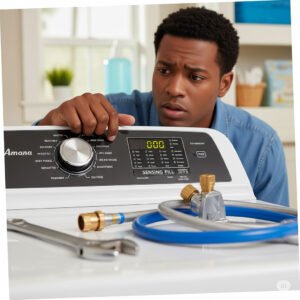To fix an Amana washer stuck on sensing fill, unplug it for 5 minutes to reset the system. Check that water supply valves are fully open and hoses aren’t kinked or clogged. Clean the inlet filters. If the issue persists, run a diagnostic cycle or replace the water inlet valve.
Dealing with an Amana washer stuck on sensing fill can be incredibly frustrating. You’ve loaded your clothes, added detergent, and pressed start, only to find your machine endlessly “sensing” without ever filling with water. This common issue can disrupt your laundry routine, but often, the solution is simpler than you might think. Before you call a repair technician, there are several troubleshooting steps you can take yourself to diagnose and potentially fix the problem.

Table of Contents
What is “Sensing Fill” Cycle in Amana Washer?
First, let’s understand what the “sensing fill” cycle actually means. When your Amana washer begins a new cycle, it enters a sensing phase. During this time, the machine is assessing the load size to determine the appropriate water level and wash action.
It does this by slowly tumbling the clothes or rotating the drum to gauge the weight and absorbency of the items. Once it has gathered this information, it should then proceed to fill with water. If your washer gets stuck in this phase, it indicates that something is preventing it from completing its assessment or moving on to the next step.
Common Reasons: Why Your Amana Washer Gets Stuck
Several factors can cause your washer to get stuck on sensing fill. Understanding these common culprits will help you pinpoint the exact issue.
1. Water Supply Issues
This is often the simplest and most overlooked cause. Your washer needs a consistent water supply to proceed.
- Closed Water Valves: Check if both the hot and cold water supply valves behind your washer are fully open. They might have been accidentally turned off or partially closed.
- Kinked or Blocked Hoses: Inspect the water inlet hoses for kinks or bends that could restrict water flow. Also, check the small screens inside where the hoses connect to the washer. These screens can get clogged with sediment or debris over time, blocking water entry.
- Low Water Pressure: If your household water pressure is too low, the washer might not detect enough incoming water to proceed with the fill cycle. This can be a neighborhood-wide issue or specific to your home’s plumbing.
2. Lid Switch Assembly Problems
The lid switch is a safety mechanism that prevents the washer from operating when the lid is open. If this switch is faulty, the washer might think the lid is still open, even when it’s closed, and therefore won’t proceed with filling.
- Misalignment: The lid strike, a small plastic piece on the lid, needs to align perfectly with the lid switch on the washer body. If it’s bent or misaligned, the switch won’t engage.
- Damaged Switch: The switch itself can wear out or become damaged, preventing it from sending the correct signal to the washer’s control board. You might hear a click when you close the lid if it’s working correctly.
3. Drain System Issues
While it might seem counterintuitive, a problem with the drain system can sometimes cause a washer to get stuck on sensing fill. If the washer detects that it cannot properly drain, it might refuse to fill to prevent overflowing.
- Clogged Drain Hose: Check for blockages or kinks in the drain hose.
- Standpipe Issues: Ensure the drain hose is inserted correctly into the standpipe and that the standpipe itself isn’t clogged.
4. Out-of-Balance Load
Modern washers are designed to detect an unbalanced load during the sensing phase. If the load is severely out of balance, the machine might pause or get stuck, trying to redistribute the weight before it fills with water.
- Overloading: Too many items can make it difficult for the washer to balance.
- Underloading: A very small load, especially with heavy items, can also cause imbalance.
- Bulky Items: Large, absorbent items like blankets or towels can clump together, leading to an unbalanced situation.
5. Control Board or Sensor Malfunctions
Less common, but still possible, are issues with the washer’s internal electronics.
- Faulty Pressure Sensor: The pressure sensor (or water level sensor) detects how much water is in the tub. If it’s faulty, it might not register that the tub is empty, preventing the fill cycle from starting.
- Main Control Board: The main control board is the “brain” of your washer. If it malfunctions, it can send incorrect signals or fail to send signals, leading to various operational issues, including getting stuck on sensing fill.
- Software Glitch: Sometimes, a temporary glitch in the washer’s software can cause it to freeze.
Amana Washer Stuck on Sensing Fill Troubleshooting Guide
Now that you understand the potential causes, let’s walk through the troubleshooting steps. Follow these in order, checking after each step if the problem is resolved.
Step 1: Power Reset Your Washer
This is the golden rule of appliance troubleshooting and often the simplest fix for electronic glitches.
- Unplug your Amana washer from the wall outlet.
- Wait for at least 1-5 minutes. This allows the control board to fully discharge any residual electricity and reset.
- Plug the washer back in.
- Open and close the lid firmly a few times.
- Start a new wash cycle and see if it proceeds past the sensing fill phase.
Step 2: Check Water Supply
This is crucial and often overlooked.
- Locate the hot and cold water supply valves behind your washer. Ensure they are both fully open (turned counter-clockwise).
- Inspect the water inlet hoses for any kinks, bends, or damage. Straighten any kinks.
- Turn off the water valves and carefully disconnect the hoses from the back of the washer.
- Check the small mesh screens inside the water inlet ports on the washer for any debris or sediment. Use needle-nose pliers or tweezers to carefully remove the screens and clean them under running water. Reinsert them once clean.
- Reconnect the hoses firmly and turn the water supply back on.
- Try running a cycle to see if the issue is resolved.
Step 3: Inspect the Lid Switch Assembly
The lid switch is vital for the washer’s operation.
- Examine the lid strike (the small plastic piece on the washer lid) to ensure it’s not bent, broken, or misaligned.
- Locate the lid switch on the rim of the washer opening. It’s usually a small plastic or metal protrusion.
- Manually depress the lid switch with your finger or a pen. You should hear a distinct click. If you don’t, the switch might be faulty.
- For some models, you might need to test continuity with a multimeter if you suspect a faulty switch. (This requires some technical skill).
- Ensure the lid closes firmly and makes good contact with the switch. If the lid is loose or misaligned, it might not activate the switch correctly.
Step 4: Redistribute the Load
If your washer is making strange noises or attempting to agitate during the sensing phase but not filling, an unbalanced load might be the culprit.
- Open the washer lid (if it unlocks).
- Manually redistribute the items inside the tub. Try to arrange them evenly around the agitator or wash plate.
- Avoid washing a single bulky item like a comforter alone; add a few towels to help balance the load.
- Do not overload the washer. Leave enough space for clothes to tumble freely.
- Close the lid and restart the cycle.
Step 5: Check the Drain System
While less common for a “sensing fill” issue, it’s worth checking.
- Ensure the drain hose is not kinked or clogged. Follow it from the washer to the standpipe or utility sink.
- Verify that the drain hose is not inserted too far into the standpipe. It should have an air gap to prevent siphoning. Usually, 4-6 inches is sufficient.
- Check for any obstructions in the standpipe itself if you suspect a blockage.
Step 6: Look for Error Codes
Some Amana washer models display error codes when there’s a problem.
- Check your washer’s display panel for any flashing lights or alphanumeric codes.
- Refer to your Amana washer’s user manual to interpret any error codes you find. The manual will often provide specific troubleshooting steps for each code.
- If you don’t have the manual, you can usually find it online by searching for your washer’s model number.
Step 7: Advanced Troubleshooting (When to Call a Professional)
If you’ve tried all the above steps and your problem is not solved, the issue might be more complex and require professional attention.
- Faulty Pressure Sensor: This sensor is responsible for detecting the water level. If it’s defective, it won’t signal the washer to fill. Replacing it usually requires disassembling parts of the washer.
- Main Control Board Failure: A malfunctioning main control board can cause a wide range of issues, including this one. Replacing a control board is often costly and best left to a trained technician.
- Motor Control Board: In some cases, issues with the motor control board can impact the sensing or filling phase.
When to Consider DIY Repair vs. Professional Help
Deciding whether to tackle a repair yourself or call a professional depends on your comfort level, technical skills, and the potential cost of parts.
Issue | DIY Difficulty | Common Fixes/Checks | When to Call a Pro |
Water Supply Issues | Easy | Check valves, hoses, inlet screens | Persistent low pressure, plumbing issues in home |
Power Glitch | Very Easy | Power reset | Issue returns immediately after reset |
Lid Switch Misalignment | Easy | Adjust lid, check alignment | Lid switch broken, no click when depressed |
Unbalanced Load | Very Easy | Redistribute clothes, avoid overloading | Continues to unbalance despite proper loading |
Clogged Drain Hose/Standpipe | Moderate | Clear blockages, adjust hose insertion | Persistent drainage issues, unable to locate/clear clog |
Lid Switch Malfunction | Moderate | Test continuity (if comfortable), replace switch | Unsure how to test, uncomfortable with internal components |
Pressure Sensor/Water Level Sen. | Advanced | Locate and replace sensor (requires opening washer) | Unsure about wiring, cannot locate part, issue persists |
Main Control Board | Expert | Check connections, replace board (costly part) | Any suspicion of board failure, high cost of part |
Safety Warning: Always unplug your Amana washer before attempting any internal inspection or repair to avoid electric shock. If you are unsure about any step, it’s always best to consult a qualified appliance technician.
FAQ
Your Amana washer may be stuck on sensing fill due to issues like a closed water supply valve, a kinked water inlet hose, a malfunctioning lid switch, an unbalanced load, or, less commonly, a faulty control board or pressure sensor. The machine is trying to determine load size but can’t proceed to fill with water.
To perform a power reset, simply unplug your Amana washer from the electrical outlet. Wait for at least one to five minutes to allow the internal components to fully discharge and reset. Then, plug the washer back in, firmly open and close the lid a few times, and try starting a new cycle.
Always check your water supply first. Ensure both the hot and cold water supply valves behind the washer are fully open. Also, inspect the water inlet hoses for any kinks or blockages, and clean the small mesh screens inside the inlet ports where the hoses connect to the washer.
Yes, an unbalanced load can definitely cause your Amana washer to get stuck. Modern washers are designed to detect imbalances during the sensing phase. If the load is too heavy on one side or tangled, the machine might pause or try to redistribute the weight before it will fill with water.
If your lid switch is faulty, you might not hear a distinct “click” when you firmly close the washer lid. Also, the washer may not start or proceed past sensing fill, even if the lid appears closed. The lid strike on the lid itself should also be visually inspected for damage or misalignment.
If you’ve tried all the basic troubleshooting steps like power resetting, checking water supply, inspecting the lid switch, and redistributing the load, and your Amana washer is still stuck on sensing fill, it’s advisable to call a qualified appliance technician. The issue might involve internal components like the pressure sensor or main control board, which are more complex to diagnose and repair.
Regular maintenance can help prevent this issue. Always ensure your water valves are open, periodically check and clean water inlet screens, avoid overloading your machine, and balance your loads properly. Also, make sure the lid and lid switch area are free of debris and that the lid closes firmly.
Final Words
Having your Amana washer stuck on sensing fill is a common problem, but often, the solution is straightforward. By systematically troubleshooting the water supply, lid switch, load balance, and performing a simple power reset, you can frequently resolve the issue yourself. If these steps don’t work, don’t hesitate to consult your user manual for error codes or contact a professional. If your appliance is stalling during the wash or rinse cycle, you can find a dedicated troubleshooting guide to solve that problem. Regular maintenance can keep your washer running smoothly, ensuring your laundry days are hassle-free.



